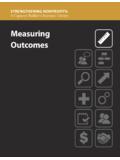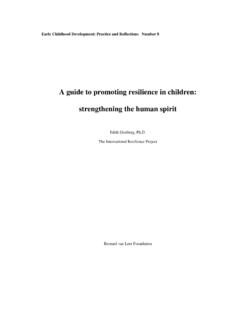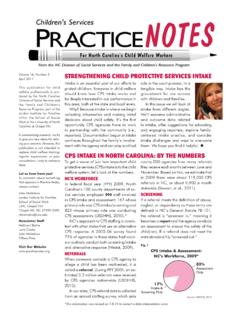Transcription of Integrated Social Protection Systems - UNICEF
1 Integrated Social Protection Systems Enhancing Equity for ChildrenUNICEF Social Protection Strategic Framework2 Key MessagesSocial Protection plays a vital role in strengthening the resilience of children, families and communities, achieving greater equity, and supporting national human and economic development. Its relevance is heightened in the face of persistent inequalities and recent trends. Expansion of Social Protection coverage is critical. UNICEF supports Progressive Realization of Universal Coverage, helping countries identify and progressively expand programmes and policies most conducive to achieving universality, while also recognizing countries different capacities and Protection programmes can be affordable and sustainably financed.
2 Long-term national financing strategies should be identified and implemented to protect and expand expenditure on effective Social Protection programmes. These are not only technical assessments, but also political promotes the development and strengthening of Integrated Social Protection Systems , which take a multi-sector approach and invest in sustainable national Systems in order to more effectively and efficiently address the multiple vulnerabilities faced by children and their , as well as economic, vulnerabilities need to be addressed by Social Protection . This requires mainstreaming Social inclusion into Social Protection programmes and using a broader range of Social Protection puts forth this Framework as a starting point for a collaborative agenda with partners on joint learning and action, in order to maximize the potential of Social Protection for furthering children s rights and well-being and for achieving equitable and sustainable Social Protection Systems for Social Protection Systems : Enhancing equity for children UNICEF Social Protection Strategic Framework For further information and permission to reproduce, contact.
3 United Nations Children s Fund3 United Nations Plaza New York, NY 10017, USA March 2012 Commentaries represent the personal views of the authors and do not necessarily reflect positions of the United Nations Children s Acknowledgements The Social Protection Strategic Framework was written by Natalia Winder and Jenn Ya-blonski in the Social and Economic Policy Analysis Unit, UNICEF . Wide consultations were held on the Framework both internally and with external partners. The team would like to thank the almost 200 UNICEF staff from Headquarters and at field level (Programme Division, Office of Emergency Programmes, Innocenti Research Centre and DPP) who provided valuable inputs and comments during the consultation process and preparation of the Framework.
4 Special thanks go to Richard Morgan, Isabel Ortiz, Jingqing Chai and David Anthony and to the UNICEF Social Protection Steering Committee and Task Force for their valuable strate-gic guidance and support. UNICEF regional Social policy advisors and officers were pivotal in facilitating regional consultations as well as providing regional perspectives and strategic inputs to enhance the global Framework: Elena Gaia and Sonia Ruiz Brunschwig (CEE/CIS), Mahesh Patel and Qimiti Paienjton (EAPRO), Gaspar Fajth and Julie Lawson-McDowall (ESARO), Roberto Benes and Louisa Lippi (MENARO), Enrique Delamonica and Victoria Colamarco (TACRO), Andrea Rossi (ROSA) and Mariana Stirbu (WCARO). Our thanks also go to Tina Johnson and Upasana Young for their help in editing and designing the final doc-ument.
5 In addition, we would like to express our gratitude to our external partners and colleagues at the African Development Bank, Department for International Development UK, Economic Policy Research Institute, European Commission, HelpAge International, Institute for Devel-opment Studies, International Labour Office, International Monetary Fund, Joint United Nations Programme on HIV/AIDS, Overseas Development Institute, Oxford Policy Manage-ment, Save the Children, UNDP, United States Agency for International Development, World Bank, World Food Programme, Young Lives-University of Oxford and others, who shared insights and experiences and provided valuable feedback for the overall approach and en-gagement with the broader Social Protection agenda.
6 We would also like to acknowledge the contribution of Armando Barrientos, Mark Davies and Nicola Hypher, who generously pro-vided critical external review and advice. Finally, very special thanks to Sheila Murthy and Deolinda Martins for their outstanding re-search and overall support. iii Foreword Since 2010, UNICEF has brought a stronger focus on equity to its own work and its engagement with the international community. I am happy to observe that, less than two years later, we have made significant progress in breathing life into this renewed focus on the most disadvantaged and excluded children. In this context, UNICEF s first ever global Social Protection Strategic Framework is an im-portant step in ensuring that we are achieving progress for children in an equitable manner, helping even the most vulnerable children reach their full potential.
7 The Social Protection Framework makes the case for investing in Social Protection for children, and demonstrates how Social Protection is a cross-cutting tool with the potential to complement invest-ments across sectors, resulting in more equitable outcomes. Social Protection helps to increase households capacity to take care of their families and overcome barriers to accessing services, such as poverty, discrimination, and remote location. While Social Protection is important for societies in general, it also reaches the most vulnerable children and families for whom barriers tend to remain even when services and national human development averages improve. For example, while improv-ing the availability of schools and quality of education will help get more children to enrol and stay in school, the children of poor families who cannot afford school supplies or depend on income from child labour are still likely to not enrol, attend less, and drop-out early.
8 Similarly, people living with HIV/AIDS may not access or receive existing health services due to mobility issues or stigma and dis-crimination. In these cases, Social Protection instruments such as cash transfers, home-based care, and anti-discrimination legislation boost income and food security and provide Social support to even the playing field so that the most excluded are also able to benefit from health, education, water and sanitation, and other Social services. The effects of Social Protection in improving the well-being of vulnerable children and their families are impressive. For example, the Red de Protecci n programme in Nicaragua reduced stunting quickly in areas where children were times more likely to be stunted than the national average.
9 Between 2000 and 2002, stunting among children enrolled in the programme reduced by percentage points more than similar children not participating with stronger impacts for poorer children. Between 2002 and 2005, the gross enrollment rate in Kenya increased from 88 percent to 112 percent, linked to the abolition of school fees. Social Protection can also simultaneously have positive impacts on multiple outcomes. Just a year after Ethiopia s Productive Safety Net Programme (PSNP) was implemented, three-quarters of beneficiary households reported consuming more or better quality food than the pre-vious year. They also reported increasing their use of healthcare and education services as a result of the programme. In South Africa, the percentage increase in the poverty headcount as a result of the international financial crisis would have been doubled without the national Child Support Grant pro-gramme.
10 Substantial evidence on the potential of Social Protection to magnify results across different areas of child wellbeing is provided in the Social Protection Strategic Framework. There is a need to act now on Social Protection . In its absence, too many children remain vulnerable to poverty, exclusion and potential risks which limit their opportunities. The urgency of addressing this critical gap is further intensified in light of persisting inequalities, unequal progress on the Millennium Development Goals, increased economic volatility, climate change, and other trends. As such, the Social Protection Strategic Framework is both timely and necessary. Given the critical need to work together to strengthen Social Protection , the Framework issues a call for action that in-cludes governments, civil society and development partners.
















